|
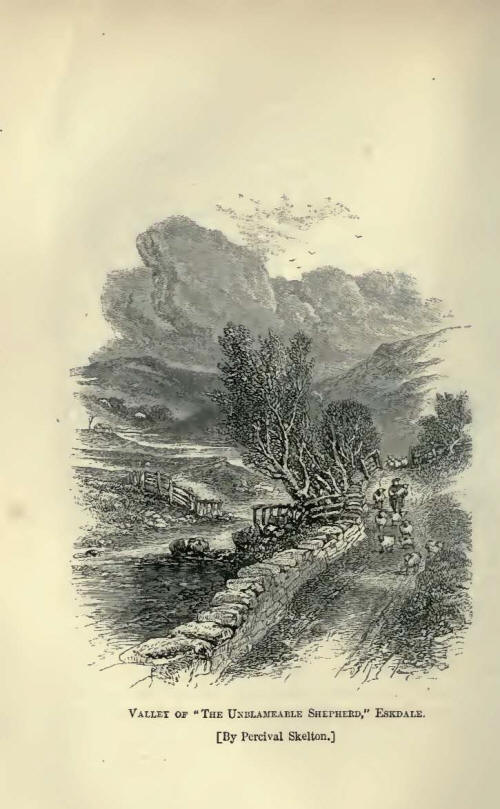
Valley of "the Unblameable Shepherd", Eskdale
Thomas Telford was born in
one of the most Solitary nooks of the narrow valley of the Esk, in the
eastern part of the county of Dumfries, in Scotland. Eskdale runs north and
south, its lower end having been in former times the western march of the
Scottish border. Near the entrance to the dale is a tall column erected on
Langholm Hill, some twelve miles to the north of the Gretna Green station of
the Caledonian Railway,--which many travellers to and from Scotland may have
observed,--a monument to the late Sir John Malcolm, Governor of Bombay, one
of the distinguished natives of the district. It looks far over the English
border-lands, which stretch away towards the south, and marks the entrance
to the mountainous parts of the dale, which lie to the north. From that
point upwards the valley gradually contracts, the road winding along the
river's banks, in some places high above the stream, which rushes swiftly
over the rocky bed below.
A few miles upward from the
lower end of Eskdale lies the little capital of the district, the town of
Langholm; and there, in the market-place, stands another monument to the
virtues of the Malcolm family in the statue erected to the memory of Admiral
Sir Pulteney Malcolm, a distinguished naval officer. Above Langholm, the
country becomes more hilly and moorland. In many places only a narrow strip
of land by the river's side is left available for cultivation; until at
length the dale contracts so much that the hills descend to the very road,
and there are only to be seen their steep heathery sides sloping up towards
the sky on either hand, and a narrow stream plashing and winding along the
bottom of the valley among the rocks at their feet.
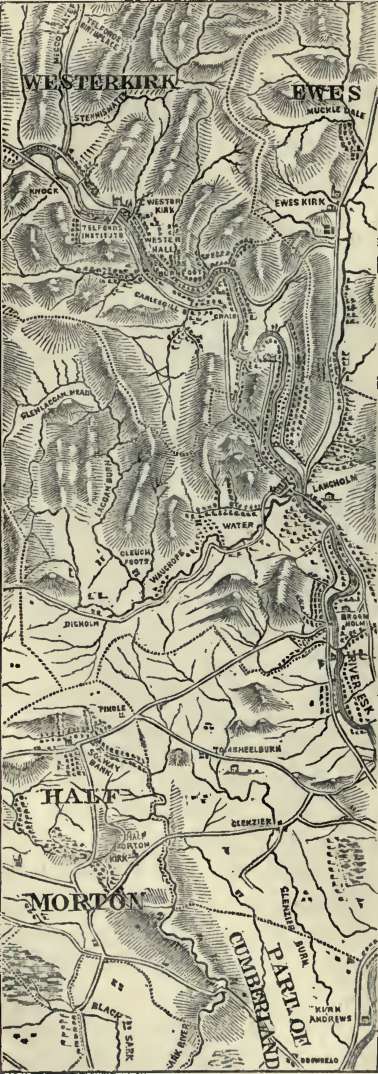
Telford's Native District
From this brief description
of the character of Eskdale scenery, it may readily be supposed that the
district is very thinly peopled, and that it never could have been capable
of supporting a large number of inhabitants. Indeed, previous to the union
of the crowns of England and Scotland, the principal branch of industry that
existed in the Dale was of a lawless kind. The people living on the two
sides of the border looked upon each other's cattle as their own, provided
only they had the strength to "lift" them. They were, in truth, even during
the time of peace, a kind of outcasts, against whom the united powers of
England and Scotland were often employed. On the Scotch side of the Esk were
the Johnstones and Armstrongs, and on the English the Graemes of Netherby;
both clans being alike wild and lawless. It was a popular border saying that
"Elliots and Armstrongs ride thieves a';" and an old historian says of the
Graemes that "they were all stark moss-troopers and arrant thieves; to
England as well as Scotland outlawed." The neighbouring chiefs were no
better: Scott of Buccleugh, from whom the modern Duke is descended, and
Scott of Harden, the ancestor of the novelist, being both renowned
freebooters.
There stands at this day on
the banks of the Esk, only a few miles from the English border, the ruin of
an old fortalice, called Gilnockie Tower, in a situation which in point of
natural beauty is scarcely equalled even in Scotland. It was the stronghold
of a chief popularly known in his day as Johnnie Armstrong.*[1] He was a
mighty freebooter in the time of James V., and the terror of his name is
said to have extended as far as Newcastle-upon-Tyne, between which town and
his castle on the Esk he was accustomed to levy black-mail, or "protection
and forbearance money," as it was called. The King, however, determining to
put down by the strong hand the depredations of the march men, made a sudden
expedition along the borders; and Johnnie Armstrong having been so
ill-advised as to make his appearance with his followers at a place called
Carlenrig, in Etterick Forest, between Hawick and Langholm, James ordered
him to instant execution. Had Johnnie Armstrong, like the Scotts and Kers
and Johnstones of like calling, been imprisoned beforehand, he might
possibly have lived to found a British peerage; but as it was, the genius of
the Armstrong dynasty was for a time extinguished, only, however, to
reappear, after the lapse of a few centuries, in the person of the eminent
engineer of Newcastle-upon-Tyne, the inventor of the Armstrong gun.
The two centuries and a half
which have elapsed since then have indeed seen extraordinary changes.*[2]
The energy which the old borderers threw into their feuds has not become
extinct, but survives under more benignant aspects, exhibiting itself in
efforts to enlighten, fertilize, and enrich the country which their wasteful
ardour before did so much to disturb and impoverish. The heads of the
Buccleugh and Elliot family now sit in the British House of Lords. The
descendant of Scott of Harden has achieved a world-wide reputation as a poet
and novelist; and the late Sir James Graham, the representative of the
Graemes of Netherby, on the English side of the border, was one of the most
venerable and respected of British statesmen. The border men, who used to
make such furious raids and forays, have now come to regard each other,
across the imaginary line which divides them, as friends and neighbours; and
they meet as competitors for victory only at agricultural meetings, where
they strive to win prizes for the biggest turnips or the most effective
reaping-machines; while the men who followed their Johnstone or Armstrong
chiefs as prickers or hobilers to the fray have, like Telford, crossed the
border with powers of road-making and bridge-building which have proved a
source of increased civilization and well-being to the population of the
entire United Kingdom.
The hamlet of Westerkirk,
with its parish church and school, lies in a narrow part of the valley, a
few miles above Langholm. Westerkirk parish is long and narrow, its
boundaries being the hill-tops on either side of the dale. It is about seven
miles long and two broad, with a population of about 600 persons of all
ages. Yet this number is quite as much as the district is able to support,
as is proved by its remaining as nearly as possible stationary from one
generation to another.*[3] But what becomes of the natural increase of
families? "They swarm off!" was the explanation given to us by a native of
the valley. "If they remained at home," said he, "we should all be sunk in
poverty, scrambling with each other amongst these hills for a bare living.
But our peasantry have a spirit above that: they will not consent to sink;
they look up; and our parish schools give them a power of making their way
in the world, each man for himself. So they swarm off--some to America, some
to Australia, some to India, and some, like Telford, work their way across
the border and up to London."
One would scarcely have
expected to find the birthplace of the builder of the Menai Bridge and other
great national works in so obscure a corner of the kingdom. Possibly it may
already have struck the reader with surprise, that not only were all the
early engineers self-taught in their profession, but they were brought up
mostly in remote country places, far from the active life of great towns and
cities. But genius is of no locality, and springs alike from the farmhouse,
the peasant's hut, or the herd's shieling. Strange, indeed, it is that the
men who have built our bridges, docks, lighthouses, canals, and railways,
should nearly all have been country-bred boys: Edwards and Brindley, the
sons of small farmers; Smeaton, brought up in his father's country house at
Austhorpe; Rennie, the son of a farmer and freeholder; and Stephenson,
reared in a colliery village, an engine-tenter's son. But Telford, even more
than any of these, was a purely country-bred boy, and was born and brought
up in a valley so secluded that it could not even boast of a cluster of
houses of the dimensions of a village.
Telford's father was a herd
on the sheep-farm of Glendinning. The farm consists of green hills, lying
along the valley of the Meggat, a little burn, which descends from the
moorlands on the east, and falls into the Esk near the hamlet of Westerkirk.
John Telford's cottage was little better than a shieling, consisting of four
mud walls, spanned by a thatched roof. It stood upon a knoll near the lower
end of a gully worn in the hillside by the torrents of many winters.
The ground stretches away
from it in a long sweeping slope up to the sky, and is green to the top,
except where the bare grey rocks in some places crop out to the day. From
the knoll may be seen miles on miles of hills up and down the valley,
winding in and out, sometimes branching off into smaller glens, each with
its gurgling rivulet of peaty-brown water flowing down from the mosses
above. Only a narrow strip of arable land is here and there visible along
the bottom of the dale, all above being sheep-pasture, moors, and rocks. At
Glendinning you seem to have got almost to the world's end. There the road
ceases, and above it stretch trackless moors, the solitude of which is
broken only by the whimpling sound of the burns on their way to the valley
below, the hum of bees gathering honey among the heather, the whirr of a
blackcock on the wing, the plaintive cry of the ewes at lambing-time, or the
sharp bark of the shepherd's dog gathering the flock together for the fauld.
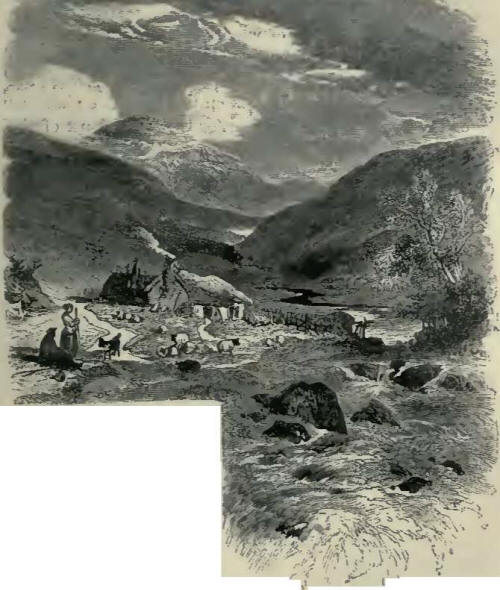
Telford's Birthplace
In this cottage on the knoll
Thomas Telford was born on the 9th of August, 1757, and before the year was
out he was already an orphan. The shepherd, his father, died in the month of
November, and was buried in Westerkirk churchyard, leaving behind him his
widow and her only child altogether unprovided for. We may here mention that
one of the first things which that child did, when he had grown up to
manhood and could "cut a headstone," was to erect one with the following
inscription, hewn and lettered by himself, over his father's grave:
"IN MEMORY OF
JOHN TELFORD,
WHO AFTER LIVING 33 YEARS
AN UNBLAMEABLE SHEPHERD,
DIED AT GLENDINNING,
NOVEMBER, 1757,"
a simple but poetical
epitaph, which Wordsworth himself might have written.
The widow had a long and hard
struggle with the world before her; but she encountered it bravely. She had
her boy to work for, and, destitute though she was, she had him to educate.
She was helped, as the poor so often are, by those of her own condition, and
there is no sense of degradation in receiving such help. One of the risks of
benevolence is its tendency to lower the recipient to the condition of an
alms-taker. Doles from poor's-boxes have this enfeebling effect; but a poor
neighbour giving a destitute widow a help in her time of need is felt to be
a friendly act, and is alike elevating to the character of both. Though
misery such as is witnessed in large towns was quite unknown in the valley,
there was poverty; but it was honest as well as hopeful, and none felt
ashamed of it. The farmers of the dale were very primitive*[4] in their
manners and habits, and being a warm-hearted, though by no means a
demonstrative race, they were kind to the widow and her fatherless boy. They
took him by turns to live with them at their houses, and gave his mother
occasional employment. In summer she milked the ewes and made hay, and in
harvest she went a-shearing; contriving not only to live, but to be
cheerful.
The house to which the widow
and her son removed at the Whitsuntide following the death of her husband
was at a place called The Crooks, about midway between Glendinning and
Westerkirk. It was a thatched cot-house, with two ends; in one of which
lived Janet Telford (more commonly known by her own name of Janet Jackson)
and her son Tom, and in the other her neighbour Elliot; one door being
common to both.
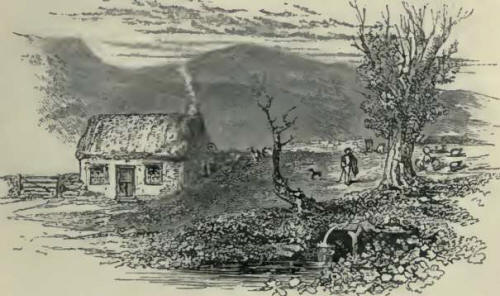
Cottage at the Crooks.
Young Telford grew up a
healthy boy, and he was so full of fun and humour that he became known in
the valley by the name of "Laughing Tam." When he was old enough to herd
sheep he went to live with a relative, a shepherd like his father, and he
spent most of his time with him in summer on the hill-side amidst the
silence of nature. In winter he lived with one or other of the neighbouring
farmers. He herded their cows or ran errands, receiving for recompense his
meat, a pair of stockings, and five shillings a year for clogs. These were
his first wages, and as he grew older they were gradually increased.
But Tom must now be put to
school, and, happily, small though the parish of Westerkirk was, it
possessed the advantage of that admirable institution, the parish school.
The legal provision made at an early period for the education of the people
in Scotland, proved one of their greatest boons. By imparting the rudiments
of knowledge to all, the parish schools of the country placed the children
of the peasantry on a more equal footing with the children of the rich; and
to that extent redressed the inequalities of fortune. To start a poor boy on
the road of life without instruction, is like starting one on a race with
his eyes bandaged or his leg tied up. Compared with the educated son of the
rich man, the former has but little chance of sighting the winning post.
To our orphan boy the merely
elementary teaching provided at the parish school of Westerkirk was an
immense boon. To master this was the first step of the ladder he was
afterwards to mount: his own industry, energy, and ability must do the rest.
To school accordingly he went, still working a-field or herding cattle
during the summer months. Perhaps his own "penny fee" helped to pay the
teacher's hire; but it is supposed that his cousin Jackson defrayed the
principal part of the expense of his instruction. It was not much that he
learnt; but in acquiring the arts of reading, writing, and figures, he
learnt the beginnings of a great deal. Apart from the question of learning,
there was another manifest advantage to the poor boy in mixing freely at the
parish school with the sons of the neighbouring farmers and proprietors.
Such intercourse has an influence upon a youth's temper, manners, and
tastes, which is quite as important in the education of character as the
lessons of the master himself; and Telford often, in after life, referred
with pleasure to the benefits which he had derived from his early school
friendships. Among those to whom he was accustomed to look back with most
pride, were the two elder brothers of the Malcolm family, both of whom rose
to high rank in the service of their country; William Telford, a youth of
great promise, a naval surgeon, who died young; and the brothers William and
Andrew Little, the former of whom settled down as a farmer in Eskdale, and
the latter, a surgeon, lost his eyesight when on service off the coast of
Africa. Andrew Little afterwards established himself as a teacher at
Langholm, where he educated, amongst others, General Sir Charles Pasley, Dr.
Irving, the Custodier of the Advocate's Library at Edinburgh; and others
known to fame beyond the bounds of their native valley. Well might Telford
say, when an old man, full of years and honours, on sitting down to write
his autobiography, "I still recollect with pride and pleasure my native
parish of Westerkirk, on the banks of the Esk, where I was born."
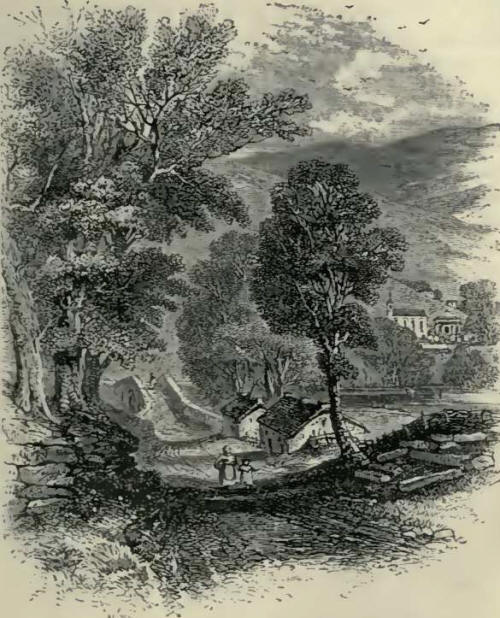
Westerkirk Church and School.
Footnotes for Chapter I.
*[1] Sir Waiter Scott, in his
notes to the 'Minstrelsy of the Scottish Border,' says that the common
people of the high parts of Liddlesdale and the country adjacent to this day
hold the memory of Johnnie Armstrong in very high respect.
*[2] It was long before the
Reformation flowed into the secluded valley of the Esk; but when it did, the
energy of the Borderers displayed itself in the extreme form of their
opposition to the old religion. The Eskdale people became as resolute in
their covenanting as they had before been in their free-booting; the
moorland fastnesses of the moss-troopers becoming the haunts of the
persecuted ministers in the reign of the second James. A little above
Langholm is a hill known as "Peden's View," and the well in the green hollow
at its foot is still called "Peden's Well"--that place having been the haunt
of Alexander Peden, the "prophet." His hiding-place was among the
alder-bushes in the hollow, while from the hill-top he could look up the
valley, and see whether the Johnstones of Wester Hall were coming. Quite at
the head of the same valley, at a place called Craighaugh, on Eskdale Muir,
one Hislop, a young covenanter, was shot by Johnstone's men, and buried
where he fell; a gray slabstone still marking the place of his rest. Since
that time, however, quiet has reigned in Eskdale, and its small population
have gone about their daily industry from one generation to another in
peace. Yet though secluded and apparently shut out by the surrounding hills
from the outer world, there is not a throb of the nation's heart but
pulsates along the valley; and when the author visited it some years since,
he found that a wave of the great Volunteer movement had flowed into Eskdale;
and the "lads of Langholm" were drilling and marching under their chief,
young Mr. Malcolm of the Burnfoot, with even more zeal than in the populous
towns and cities of the south.
*[3] The names of the
families in the valley remain very nearly the same as they were three
hundred years ago--the Johnstones, Littles, Scotts, and Beatties prevailing
above Langholm; and the Armstrongs, Bells, Irwins, and Graemes lower down
towards Canobie and Netherby. It is interesting to find that Sir David
Lindesay, in his curious drama published in 'Pinkerton's Scottish Poems'
vol. ii., p. 156, gives these as among the names of the borderers some three
hundred years since. One Common Thift, when sentenced to condign punishment,
thus remembers his Border friends in his dying speech:
"Adew! my bruther Annan
thieves,
That holpit me in my mischeivis;
Adew! Grosaws, Niksonis, and Bells,
Oft have we fairne owrthreuch the fells:
Adew! Robsons, Howis, and
Pylis,
That in our craft hes mony wilis:
Littlis, Trumbells, and Armestranges;
Baileowes, Erewynis, and Elwandis,
Speedy of flicht, and slicht of handis;
The Scotts of Eisdale, and the Gramis,
I haf na time to tell your nameis."
Telford, or Telfer, is an old
name in the same neighbourhood, commemorated in the well known border ballad
of 'Jamie Telfer of the fair Dodhead.' Sir W. Scott says, in the
'Minstrelsy,' that "there is still a family of Telfers. residing near
Langholm , who pretend to derive their descent from the Telfers of the
Dodhead." A member of the family of "Pylis" above mentioned, is said to have
migrated from Ecclefechan southward to Blackburn, and there founded the
celebrated Peel family.
*[4] We were informed in the
valley that about the time of Telford's birth there were only two
tea-kettles in the whole parish of Westerkirk, one of which was in the house
of Sir James Johnstone of Wester Hall, and the other at "The Burn," the
residence of Mr. Pasley, grandfather of General Sir Charles Pasley. |

